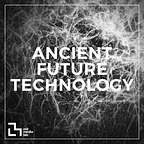Nature’s Living Memorial
By Elaine Regina
Nature’s Living Memorial
Elaine Regina responds to
What might we store in the Data Forests of the future?
As I think about Future Data Forests, I am reminded of historical events that shape Earth’s life throughout eons, from the “primordial soup” of organic and inorganic compounds that formed microbes, to the colossal and ever-continuous spread of DNA replication and mutation. In the chain of events that lead to speciation, that shape how living matter and beings on the planet evolve. During the evolution of prokaryotic cyanobacteria, oxygenic photosynthesis caused mass extinctions of anaerobic species, but ultimately led to the origins of plant and algae. As climate changes, supercontinents and multiple prehistoric species come and go. The four-limbed Tiktaalik fish flopped its way from the sea to the land, bringing life to all vertebrates including us humans……. When I think about what kind of stories or data I would like to store for the future, I consider Data Forests as Nature’s Living Memorial.
The following scenarios come to mind when I speculate about how Nature's Living Memorial might operate with existing technology:
1:
Plant-based digital data storage involves storing digital data in plants and seeds. By creating artificial gene sequences that contain the four base pairs of DNA (ACGT) to represent binary bits within the encoded information, it can be stored and multiplied within plants without harming them.
A prime example is demonstrated in the ‘Grow Your Own Cloud’s Data Garden’ installation, featuring plants encoded with digital data converted from text, JPEGs and MP3s into biological format. In this example DNA uses ACGT rather than binary to encode information. Within the installation, the plants’ DNA is decoded in real time using the latest genetic sequencing technologies, and displayed in space, revealing hidden messages stored in their genetic code.
In the TV Series Black Mirror S1E3, “The Entire History of You” a technological device called “the grain” was introduced. The grain is a device attached to humans that records audiovisual senses by default. The individual(s) could rewind any memory they want to access and relive, and it could even be shared with others on a big screen like a projector. When accessing the technology, a Heads Up Display (HUD)/Augmented Reality (AR) Display pops up within their visual field. Technology such as this isn't that far-fetched given the development of Microchip technology and the extensive research on brain-computer interfaces with companies such as Elon Musk's Neuralink. We are closer to transhumanism than ever.
Combining the two aforementioned inspirations, Nature’s Living Memorial could facilitate the storage of data about a species' life cycle as well as its ancestry. Humans might then be able to experience the memories of another species; giving other species more agency in human affairs and bringing humans closer to understanding nature’s unique personal stories.
2:
Nature’s Living Memorial might operate with Artificial Intelligence (AI) & Machine Learning (ML) that learns and augments nature’s behavior, giving a “voice” and agency to nonhuman entities.
Drawing on Earth Species Project's work on decoding non-human and animal communication using bioacoustics, Nature's Living Memorial may give a sense of personality to the terrestrial environment by translating input through AI/ML to an interpretable response. A small quake of the earth could be understood as the mountains or underground walking or dancing. When trees start to sprout their buds of leaves or flowers, it could be understood as their slowly waking up from the long sleep of the winter. Trees could even warn us when they are in pain, for example when their bark is under attack by pests or when they are getting cut down. Through AI/ML, humans could hopefully see nature in a new light.
What is the purpose of Nature’s Living Memorial? Through the conveyance of data, stories, and agencies…. I hope that it could build empathy and understanding between nature and humans. Modern society has come apart from nature, resulting in an ongoing climate emergency. By building empathy from humans to nature, we could hopefully change human beings’ (the “supposedly caretaker” of the earth) ecological impact on the planet. During the anthropocene era in the last 100 years, Nature has suffered badly. What would happen if we had access to a data forest that could facilitate empathy-based communication, storytelling, and relations between species? Perhaps that would be a good start. And maybe, just maybe..... things will work out differently in the future.
Humans might then be able to experience the memories of another species; giving other species more agency in human affairs and bringing humans closer to understanding nature’s unique personal stories.
Elaine Regina is a postdisciplinary designer, researcher, and maker; with major interests in biodesign, sustainable systems & speculative futures.
Author IG or other Social Media info: Instagram @elainereginaaa
#ancientfuturetechnology #mitmedialab #ancestors #widsom #nextsevengenerations #data #AI #ML #machinelearning #forests #dna #encoding #synbio #syntheticbiology
